U.S. Department of Transportation
Federal Highway Administration
1200 New Jersey Avenue, SE
Washington, DC 20590
202-366-4000
FHWA Resource Center
Office of Innovation Implementation
Adobe PDF Version of the Environmental Quarterly
Volume 3, Issue 1
January 2007
LETTER FROM THE EDITOR
Dear Environmental Colleague,
Happy 2007! We are kicking off the year with a feature article by guest author, Matt Fuller from the Illinois Division Office that reviews the IL MSAT peer exchange. We’ll also explore American Indian best practices in an article penned by our very own Stephanie Stoermer.
As always, we welcome your story ideas and submissions. On behalf of the Environment Technical Service Team, I wish you the very best 2007 possible.
Sincerely, Don Cote
Environment Technical Service Team (TST) Leader &
Editor–in-Chief
Phone: (720) 963-3210
E-mail: Don.Cote@fhwa.dot.gov
INSIDE
• IL Hosts MSAT Peer Exchange
• American Indian Best Practices
• STEP Research Program Unveiled
• Corps’ Permits Expiring
• Environmental Calendar
Illinois DOT Hosts MSAT Peer Exchange
By Matt Fuller, Environmental Programs Engineer, Illinois Division Office

Caption: Image of the Illinois Department of Transportation logo
Air quality agencies and the public have a great deal of interest in transportation projects and the effects these projects have on air quality. The Federal Highway Administration (FHWA) and State Departments of Transportation (DOTs) are familiar with air quality conformity requirements and hot-spot analyses; however, the issue of Mobile Source Air Toxics (MSATs) and transportation projects is an emerging topic many in the transportation profession are not familiar with. In February of 2006, FHWA released Interim Guidance on Air Toxic Analysis in NEPA Documents to provide a framework for addressing MSATs on FHWA projects. The Illinois Department of Transportation (IDOT) developed procedures to incorporate FHWA’s interim guidance into their project development process, which led them to ask, what are other mid-western states doing to address air toxics in the National Environmental Policy Act (NEPA) phase of project development?
To find the answer to this question, IDOT organized a peer exchange and invited transportation professionals from State DOTs representing Minnesota, Wisconsin, Michigan, Ohio, and Indiana. The IDOT also invited United States Environmental Protection Agency (USEPA) Region 5, Illinois EPA, staff from the Division Offices in the mid-western states, and air toxic experts from the FHWA Resource Center to participate in the peer exchange. The peer exchange was held on October 5th and 6th at the Allerton Park and Retreat Center in Monticello, Illinois, 25 miles southwest of Urbana-Champaign.
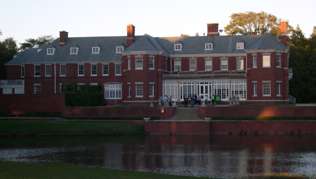 Caption: A photo of the Allerton Park Conference Center, a large red brick building, in Monticello, Illinois. |
The USEPA began the discussion on air toxics by presenting the background of the Clean Air Act and the regulatory issues dealing with air toxics. Jeff Houk and Mike Claggett from FHWA’s Resource Center followed by giving an introduction and background on MSATs and discussed FHWA’s Interim MSAT Guidance. They also described project-level methodologies for analyzing MSATs and some real world examples of analyses that have been completed around the country. After the introductory material was presented, USEPA described the latest university research that is being done on MSATs.
To round out the first day, the topic turned to air quality monitoring data near two major transportation facilities in Illinois. The Illinois EPA gave a presentation describing their air toxic monitoring results near Chicago O’Hare International Airport, which showed among their findings that the highest levels of most air toxics were not found near O’Hare, but in industrialized areas in southeast Chicago. The IDOT described the results of the air quality monitoring they have obtained during the reconstruction of the Dan Ryan Expressway (Interstate 90/94) in Chicago, a facility that carries over 300,000 vehicles per day in some locations. The monitoring data that has been collected thus far has shown that elevated air readings can not be directly related to the Dan Ryan reconstruction activities. At times, when elevated PM air quality readings were recorded near the reconstruction project, the elevated readings appear to be related to the overall air quality in the Chicago Metropolitan Area.
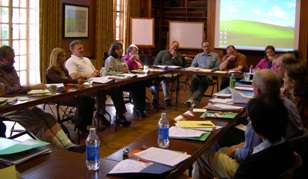 Caption: Photo of the Midwest MSAT Peer Exchange Participants sitting in a conference room at tables, engaging in discussions. |
On the second day of the peer exchange, at a round-table discussion, each participant had an opportunity to describe how their state was reporting MSATs in their NEPA documents and share their experience with MSAT analysis on specific projects. Each state had something unique to share, and there were a variety of approaches to reporting MSATs in NEPA documents. Jeff Houk described MSAT training and other resources that are available for addressing MSAT issues. Mike Claggett gave an overview of FHWA’s Easy Mobile Inventory Tool (EMIT), which greatly simplifies project-level MSAT emissions analysis. The peer exchange concluded with the conference facilitator, Dr. Jane Lin from the University of Illinois at Chicago, guiding the group through an exercise to identify MSAT research needs for project level analysis.
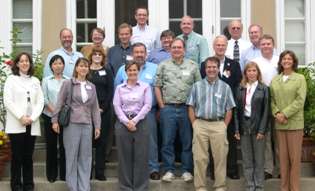 Caption: Group photo of the Midwest MSAT Peer Exchange Participants at the Allerton Park Conference Center. |
The Midwest MSAT peer exchange was an excellent forum for discussing the MSAT issues related to transportation projects. The participants left with a deeper understanding of MSATs as well as making important connections with their counterparts in nearby states. The University of Illinois at Chicago developed and is maintaining a website dedicated to the Midwest MSAT peer exchange. The MSAT website contains information that other states could find useful, including copies of the presentations given at the peer exchange, reports documenting MSAT analysis on real-world projects, and proceedings from the peer exchange, which will also be sent all State DOTs.
Matt Fuller is an Environmental Programs Engineer at the FHWA Illinois Division Office. You may contact him at:
3250 Executive Park Drive
Springfield, IL 62703
Matt.Fuller@fhwa.dot.gov
217-492-4625
PHOTOGRAPHIC CREDIT: All photographs by Mr. Wenjing Pu
AMERICAN INDIAN BEST PRACTICES: NORTH DAKOTA TAKES A COLLABORATIVE APPROACH to TRIBAL CONSULTATION
By Stephanie Stoermer
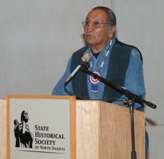 Caption: Photo of Mr. William Ambrose Littleghost, elder and cultural advisor, Sprit Lake Dakotah standing at a podium speaking and reflecting on the significance of the programmatic agreement. |
The Secretary of Interior’s Standards and Guidelines for Federal Agency Historic Preservation Programs Pursuant to the National Historic Preservation Act provides the definition of consultation: “Consultation means the process of seeking, discussing, and considering the views of others, and, where feasible, seeking agreement with them on how historic properties should be identified, considered, and managed.” But for the various parties involved particularly Indian Tribes, the consultation process also speaks to achieving mutual trust, building lasting relationships, and working in a collaborative yet culturally respectful manner.
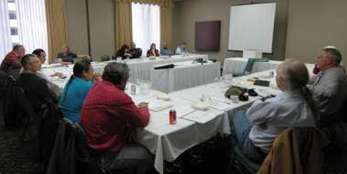 Caption: Photo of Tribal consultation meeting, showing participants in a meeting room sitting at conference tables. |
Using an innovative and possibly unprecedented approach to developing and executing a agreement document with multiple Tribes in multiple states, the North Dakota Department of Transportation (NDDOT) and the FHWA North Dakota Division found a way, in consultation with twelve tribes in North Dakota, South Dakota, Montana and Minnesota, to tailor the consultation process to NDDOT needs while addressing tribal concerns about cultural resources that may be affected by NDDOT projects. The Tribes involved are: the Mandan, Hidatsa, Arikara Nation; Turtle Mountain Band of Chippewa Indians; Spirit Lake Dakotah Nation; Standing Rock Sioux Tribe, Sisseton/Wahpeton Oyate; Fort Peck Assiniboine & Sioux Tribes; Northern Cheyenne Tribe; Crow Tribe; and Lower Sioux Indian Community.
The legal mandate that requires the Federal Highway Administration and other Federal agencies to consult with Indian tribes on a government-to-government basis is more than 200 years old. The consultation requirement was initiated with the Constitution, in Article I Section 8 (also referred to as the “Commerce Clause”) which empowers Congress to regulate commerce and consult with foreign governments, between the states and with the Indian Tribes. The constitutional mandate to respect tribal sovereignty has also been repeatedly expressed in statutes, executive orders and policies, including the National Historic Preservation Act of 1966, as amended (16 U.S.C. 470).
Properties of religious and cultural significance to Indian tribes or Native Hawaiian Organizations are frequently located on ancestral, aboriginal, or ceded lands. In acknowledgement of the critical need to consult with Indian tribes regarding such historic properties, the National Historic Preservation Act was amended in 1992 to require all Federal agencies to consult with Indian tribes on undertakings which may affect properties of traditional religious and cultural significance on or off Tribal lands. The Section 106 regulations (36 CFR 800, Protection of Historic and Cultural Properties) implementing National Historic Preservation Act were revised in 2001 to reflect this change.
Accordingly, Federal agencies are required to make a reasonable and good faith effort to identify Indian tribes that attach significance to properties of traditional religious and cultural significance that may be affected by a proposed undertaking but due to the circumstances of history may now live at a great distance from the undertaking. The Advisory Council on Historic Preservation (ACHP) points out in its guidance Consulting with Indian Tribes in the Section106 Review that “although an Indian tribe may not have visited a historic property in the recent past, its importance to the tribe or its significance as a historic property of religious and cultural significance may not have diminished for purposes of Section 106.”
Because the consultation requirement for properties of traditional religious and cultural importance applies regardless of the location of both the historic property and the Indian tribe, the 1992 amendments to the National Historic Preservation Act and the 2001 revisions to 36 CFR 800 posed major logistical, temporal, and cultural challenges to all parties involved in the consultation process.
Despite the long-standing mandate requiring government-to-government consultation with Tribes, many federal agencies had little or no experience with tribal consultation nor did they have formal tribal consultation procedures in place. Certainty regarding who, when, where, and precisely how to conduct meaningful consultation was problematic.
Even when Federal agencies were successful in their attempts to identify and consult with the appropriate tribe or tribe, some tribal governments’ limited resources were often overextended--not only by requests for consultation but by demands for information regarding traditional religious and cultural properties. Differing communication styles and cultural perceptions, as well as Tribal concerns about the release of confidential information to the public regarding these sensitive properties, made building mutual trust and establishing long-term relationships difficult.
In 2005, the National Association of Tribal Preservation Offers (NATHPO) study Tribal Consultation: Best Practices in Historic Preservation was able to report “what began in 1992 as amendments to the National Historic Preservation Act and was reiterated in several Executive Orders regarding consultation with Tribes, has begun to filter into the rubric of daily practice for Federal Agencies and other government entities whose undertakings impact Tribal sites and concerns.” Nevertheless, in spite of improved communication and improved procedures, Federal agencies and Tribes continue to face challenges in the consultation process.
To meet these challenges, Federal agencies and Tribes have increasingly taken advantage of opportunities provided by 36 CFR 800 to both strengthen and streamline the consultation process by executing programmatic agreements (PAs) that stipulate precisely how the respective Tribe or Tribes will to be consulted with.
While the FHWA cannot delegate its government-to-government responsibility and overall consultation and coordination responsibility duties, the FHWA may rely on State DOTs to carry out day-to-day and project specific consultation, as long as the Tribes agree, per Section 800.2 (c)(4) of the Section 106 regulations. Until quite recently, most of the PAs between the FHWA Divisions, their State DOT partners, and Tribes relating to federally-funded transportation programs or projects executed have been executed with individual, rather than multiple tribes.
Although the NDDOT has been working and consulting on a one-to-one basis with eleven Tribes from eight Reservations for many years, there was no clear agreement of what was adequate or necessary. The new PA dramatically changes how NDDOT and FHWA consult with the tribes—now all of the parties will work together as a group. The idea to work as a group came from the Tribes, who felt that with their varying expertise they were stronger and more effective when functioning together and that it would reduce the demands on their time.
The issues addressed in the PA were carefully written and re-written by all participants to reflect those items they believed important to document. However, other primary issues identified as important to the Tribes for inclusion in the PA were 1) acknowledgement of who they are in regard to the language and the “heart” expressed in the document, 2) pursuit of cross-cultural training opportunities, 3) commitment to providing an explanation of management decisions reached by the NDDOT and the FHWA in regard to issues of concern to them, 4) confidentiality of information they may discuss with NDDOT that they regard as sensitive, and 5) a willingness to cover expenses to facilitate their participation in this effort.
Issues important to the NDDOT and the FHWA North Dakota Division were to have a defined approach to tribal consultation that 1) was honest and straightforward, 2) clearly excluded types of projects that were not of concern to the Tribes, thus facilitating and streamlining the process), 3) satisfied the compliance issues for FHWA, 4) provided an opportunity for cross-cultural training to facilitate effective consultation, 5) clearly met the needs of the Tribes so that the relationship between the various parties would be based on mutual trust and respect.
The PA for Tribal Consultation in North Dakota takes the intent of the law to heart and gives tribal people a seat at the table in consideration of cultural resources that may be affected by transportation projects. The signing of this landmark PA was initiated in a ceremony was held on November 28, 2006 at the North Dakota Heritage Center in Bismarck. Representatives from the Tribes, the FHWA North Dakota Division; the NDDOT and the Governor's Chief of Staff were in attendance. Ambrose Littleghost, Cultural Advisor, Spirit Lake Tribe, gave traditional opening and closing prayers. The All Nations Drum Group and the Redrock Drum Group provided songs at critical points in the ceremony, explaining the significance of each song for the benefit of the audience.
|
The NDDOT Director Francis Ziegler, FHWA North Dakota Division Administrator Allen Radliff, and representatives from three reservations signed the agreement. The signatures from the six remaining reservations will be obtained over the next few weeks.
Following the signing ceremony, Tribal Chairpersons, Tribal Cultural Resource Persons and NDDOT Cultural Resource staff offered their reflections on the occasion. Commemorative plaques were then presented to the Tribal Chairpersons and Tribal Cultural Resource Persons who had been instrumental in developing the PA as well as to representatives from NDDOT and the FHWA North Dakota Division.
 Caption: Group photo of North Dakota Tribal Consultation PA Plaque Honorees. Back row: Byron Olson, Archaeologist Standing Rock THPO; Conrad Fisher, THPO Northern Cheyenne; Mark Schrader, FHWA ; Curley Youpee, Director Cultural Resources Department Fort Peck Assiniboine and Sioux Tribes; Franky Jackson, Consultant to Lower Sioux Indian Community; Calvin Grinnell, Cultural Resource Specialist, Mandan Hidatsa & Arikara Nation; Allen Radliff, FHWA ; Kent Good, Consultant to NDDOT; Elgin CrowsBreast, THPO Mandan Hidatsa Arikara Nation; Front Row: Francis Ziegler, NDDOT Director; Jeani Borchert, NDDOT Tribal Consultation Specialist; Pam Halverson, THPO Lower Sioux Indian Community; Ambrose Littleghost, Cultural Advisor, Spirit Lake Dakotah Nation; Richard Bird, Jr., Chairman Economic Committee and Councilman at Standing Rock Sioux Tribe; Scott German, Vice-Chairman, Sisseton Wahpeton Oyate; Shannon Blue, President Lower Sioux Indian Community; Dianne Desrosiers, THPO Sisseton Wahpeton Oyate. |
This agreement is likely serve as a model for other State DOTs and FHWA Divisions seeking to consult with multiple tribes in a proactive, culturally sensitive and collaborative manner. More importantly, the Tribes who are signatories to the PA for Tribal Consultation in North Dakota would like to see similar PAs developed with the other states to which they have ancestral ties, including Minnesota, Montana, and South Dakota.
Photo Credit:
All Photos courtesy of NDDOT.
For more information about the PA for Tribal Consultation in North Dakota, please contact:
Mark Schrader
FHWA North Dakota Division
(701) 250-4343 ext 111
Mark.Schrader@fhwa.dot.gov
Jeani Borchert
Cultural Resource Section
North Dakota Department of Transportation
(701) 328-4378
jborcher@nd.gov
For more information regarding tribal consultation
For information regarding training related to tribal consultation issues, please contact:
Stephanie Stoermer
FHWA Resource Center
(720) 963-3218
Stephanie.Stoermer@fhwa.dot.gov
David Grachen
FHWA Resource Center
(404) 562-3668
David.Grachen@fhwa.dot.gov
STEP Research Program Unveiled for Environment
The Resource Center will be looking to provide support and technical assistance for 33 environmental initiatives identified in the FY 2007 STEP Research Plan. STEP is the Surface Transportation Environment and Planning Cooperative Research Program (STEP). Per Section 5207 of the SAFETEA-LU, $5.56 million per year for FY2006-FY2009 will be available to implement 33 environmental initiatives. $6.19 million will be available each of these fiscal years for Planning Focus areas, Planning Emphasis Areas and Support tools for the various initiatives and emphasis areas. Like many Resource Center efforts, the general objective of the STEP is to improve understanding of the complex relationship between surface transportation, planning and the environment. For more information and contacts for the various STEP emphasis areas.
The STEP has identified 8 emphasis areas for the environment and 33 initiatives with those emphasis areas. The 33 initiatives are:
Air Quality and Global Climate Change
1. Testing, Evaluation and Validation of New Emission Model
2. Research on Conducting Project Level Analysis of Particulate Matter (PM) Emissions
3. Survey and Assessment of State and Local Climate Change Activities, and Transportation and Dissemination of Research and Best Practices
4. CMAQ: Developing Strategies and Improved Information for Future Project Selection
5. Literature Review of Air Toxics and PM Research
6. Support for Climate Change Center Research
7. Ongoing Support for the Gulf Coast Study on Analyzing Impacts of Climate Change on Transportation Infrastructure
Water Wetlands, Vegetation, Wildlife Habitat
8. Advancing Methods, Maps, and Tools Used for Decision Support and Impact Analyses for Transportation, Wildlife, & Ecological Systems
9. International Stormwater BMP Database
10. FHWA Pollutant Loadings Model
11. Wildlife Usage of Wetland Mitigation Areas
12. Economic and Ecological Benefits of Reduced Mowing (including wildlife)
13. Environmental Benefits of Using Recycled Materials on Transportation Projects
14. Research and Innovation Agreements with USFWS, USACE, and USFS
15. Linking Eco-logical to Planning and Project Development
Historic Preservation
16. Research and Innovation Agreement with Advisory Council on Historic Preservation
Bicycle/Pedestrian and Health
17. Collection of Data on Pedestrian and Bicycle Use and the Extent of Facilities
Noise
18. FHWA Traffic Noise Model Version 3.0 Development
19. FHWA Traffic Noise Model Increased Ldn Capability
20. FHWA Traffic Noise Model/Pavement Validation Study
21. Tire/Pavement Noise Measurements: Temperature Effects Study
22. Tire/Pavement Noise Research Consortium Pooled Fund
Outdoor Advertising Control/Realty Program Management
23. The Safety Effects of Electronic Advertising Signs on Driver Attention
24. Identifying Research Questions on the Impact of Outdoor Advertising to the Economy of the Surrounding Area
Environmental Streamlining/Stewardship
25. Linking Eco-logical to Planning and Project Development
26. Executive Order 13274 Implementation Activities
27. Environmental Competency Building
28. Advancing Innovations in FHWA's Environmental Review Process
29. Assessment of the Surface Transportation Project Delivery Pilot Program: Evaluating FHWA's Role in the NEPA Process
30. Environmental Stewardship and Streamlining Outreach and Technology Transfer
Context Sensitive Solutions
31. Context Sensitive Solutions (CSS) Clearinghouse
32. Advancing Context Sensitive Solutions (CSS) Implementation: Stakeholder Exchange
33. CSS Pooled Fund Study
To request technical assistance in these areas from the Resource Center Environment Team, contact Don Cote, FHWA Resource Center Environmental Technical Services Team Manager, at don.cote@fhwa.dot.gov or (720) 963-3210.
Corps' Current Nationwide Permits Expiring
The Corps of Engineers’ nationwide permit (NWP) issued on March 18, 2002 will expire on March 18, 2007. The Corps’ August 4, 2005 Regulatory Guidance Letter (05-03) indicates that projects that have an existing NWP and have commenced work or are under contract for the work will have until March 18, 2008 (one year) to complete the work under the current NWP. If you submit an application before the March 18, 2007 expiration date and an NWP is issued you will have until March 18, 2008 to complete the project if you commence work or are under contract for the work before the NWP expires. If no work or contract is initiated before March 18, 2007 the NWP becomes invalid. Extensions beyond March 18, 2008 are negotiable and subject to the type of work still remaining to be completed. A request for an extension must be submitted in writing by February 18, 2008. Applications that do not get verification letters prior to March 18, 2007 will be reviewed under the new NWP terms and conditions. You may visit the applicable Corps Regulatory District websites to find out how the new NWP program, regional conditions and/or regional permits are being rolled out.
Jaclyn Lawton to Retire
Jaclyn Lawton, Environmental Programs Engineer, for the Wisconsin Division is retiring after 31 1/2 years of service, all in Wisconsin Division. Jacki also worked in Planning and Research and as an Area Engineer. Jacki was associated with Wisconsin’s first wetland mitigation efforts and several EISs including the first with a “No Build” preferred alternate and the first tiered EIS. Jacki graduated from the University of Wisconsin – Madison with a Civil Engineering degree. Cards and letters should be sent to Chris Salberg for a memory book at 567 D'Onofrio Drive, Madison, WI 53719
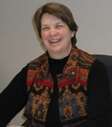 Caption: Photo of Jacki Lawton |
Paul Tufts Retires from FHWA
Congratulations to Paul Tufts of the Environmental Team of the FHWA-Resource Center, who retired from a 39 year career with FHWA. Paul’s career included a Secretary of Transportation Award for Community Service, and accomplishments as an Area Engineer, Regional Research Engineer, and Environmental Specialist. Paul’s expertise in Tribal Coordination, NEPA, and 4(f), has been an essential asset for FHWA, the Transportation Research Board, and Tribal Technical Assistance Program (TTAP) efforts.
Paul’s retirement will include travel adventures including multiple trips within the U.S. and an excursion to South Africa this year. Thank you, Paul, and best wishes in this new phase of life!
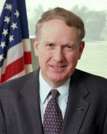 Caption: Photo of Paul Tufts |
What's Going On?
Here are a few of the upcoming events of interest to the environmental community:
January 2007
January 28 - February 1
2007 USDA-CSREES National Water Conference
Savannah, GA
February 2007
February 11 - 14, 2007
2007 NASCC Corps Forum
Washington DC
March 2007
March 6 - 8, 2007
2007 Trailbuilders Conference
Reno, NV
March 22-23
National Off Highway Vehicle Program
Managers Workshop
Charleston WV
April 2007
April 10-13
National Mitigation Banking & Conservation
Conference: The Next Decade of Banking
St. Louis, MO
May 2007
May 13 - May 17
Coastal Sediments 2007
New Orleans, LA
May 20 - May 25
Int'l Conference on Ecology & Transportation (ICOET) "Bridging the Gaps, Naturally"
Little Rock, AR
For additional conferences and events, see the FHWA's Planning, Environment & Realty calendar.
CONTACT INFORMATION:
Editor–in-Chief
Don Cote
Environment Technical Service Team (TST)
Team Manager
Phone: (720) 963-3210
don.cote@fhwa.dot.gov
TST Editorial Board Members:
David Grachen, Brian Smith, and David Sullivan
FHWA Resource Center
Aung Gye
Office of Project Development &
Environmental Review, FHWA HQ
Managing Editor:
Marie Roybal,
FHWA Resource Center
(720) 963-3241
marie.roybal@fhwa.dot.gov
Due to Quarterly publication schedule, all article submissions for future issues are due to the Editor-In-Chief by the 15th of March, June, September, and/or December
*If you would like to receive this newsletter electronically, please send your email address to:
marie.roybal@fhwa.dot.gov